Irodov Solutions: Photometry & Geometrical Optics | I. E. Irodov Solutions for Physics Class 11 & Class 12 - JEE PDF Download
Q.1. Making use of the spectral response curve for an eye (see Fig. 5.1), find:
(a) the energy flux corresponding to the luminous flux of 1.0 lm at the wavelengths 0.51 and 0.64 pm;
(b) the luminous flux corresponding to the wavelength interval from 0.58 to 0.63 tim if the respective energy flux, equal to  = 4.5 mW, is uniformly distributed over all wavelengths of the interval.
= 4.5 mW, is uniformly distributed over all wavelengths of the interval.
The function V (λ) is assumed to be linear in the given spectral interval.
Ans. (a) The relative spectral response V(λ) shown in Fig. (5.11) of the book is so defined that A/V (λ) is the energy flux of light of wave length λ, needed to produce a unit luminous flux at that wavelength. (A is the conversion factor defined in the book.)
At λ = 0.51 μm, we read from the figure

energy flux corresponding to a luminous flux of 1 lumen 
At

and energy flux corresponding to a luminous flux of 1 lumen 
(b) 
since energy is distributed uniformly. Then

since V (λ) is assumed to vary linearly in the interval  we have
we have

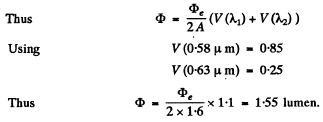
Q.2. A point isotropic source emits a luminous flux  lm with wavelength λ = 0.59 μm. Find the peak strength values of electric and magnetic fields in the luminous flux at a distance r = = 1.0 m from the source. Make use of the curve illustrated in Fig. 5.1.
lm with wavelength λ = 0.59 μm. Find the peak strength values of electric and magnetic fields in the luminous flux at a distance r = = 1.0 m from the source. Make use of the curve illustrated in Fig. 5.1.
Ans.
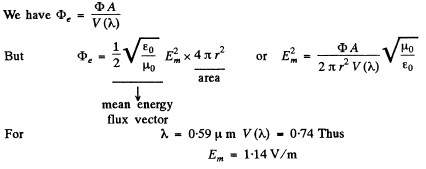
Also 
Q.3. Find the mean illuminance of the irradiated part of an opaque sphere receiving
(a) a parallel luminous flux resulting in illuminance E0 at the point of normal incidence;
(b) light from a point isotropic source located at a distance l = = 100 cm from the centre of the sphere; the radius of the sphere is R = 60 cm and the luminous intensity is I = 36 cd.
Ans. (a) Mean illuminance

Now, to calculate the total luminous flux incident on the sphere, we note that the illuminance at the point of normal incidence is E 0 . Thus the incident flux is  Thus
Thus
Mean illuminance 

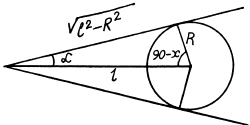


The area irradiated is :
Thus 
Substituting we get 
Q.4. Determine the luminosity of a surface whose luminance depends on direction as L = Lo cosθ, where θ is the angle between the radiation direction and the normal to the surface.
Ans. Luminance L is the light energy emitted per unit area of the emitting surface in a given direction per unit solid angle divided by cosθ. Luminosity M is simply energy emitted per unit area.
Thus

where the integration must be in the forward hemisphere of the emitting surface (assuming light is being emitted in only one direction say outward direction of the surface.) But
Thus
Q.5. A certain luminous surface obeys Lambert's law. Its luminance is equal to L. Find:
(a) the luminous flux emitted by an element ΔS of this surface into a cone whose axis is normal to the given element and whose aperture angle is equal to θ;
(b) the luminosity of such a source.
Ans. For a Lambert source L = Const
The flux emitted into the cone is
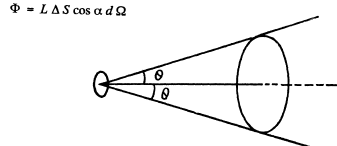

(b) The luminosity is obtained from the previous formula for θ = 900

Q.6. An illuminant shaped as a plane horizontal disc S = 100 cm2 in area is suspended over the centre of a round table of radius R = 1.0 m. Its luminance does not depend on direction and is equal to L = 1.6.104 cd/m2. At what height over the table should the illuminant be suspended to provide maximum illuminance at the circumference of the table? How great will that illuminance be? The illuminant is assumed to be a point source.
Ans. The equivalent luminous intensity in the direction OP is
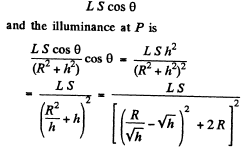

This is maximum when and the maximum illuminance is R = h

Q.7. A point source is suspended at a height h = 1.0 m over the centre of a round table of radius R = 1.0 m. The luminous intensity I of the source depends on direction so that illuminance at all points of the table is the same. Find the function I (θ), where θ is the angle between the radiation direction and the vertical, as well as the luminous flux reaching the table if I (0) = I0 = 100 cd.
Ans. The illuminance at P is

since this is constant at all x, we must have

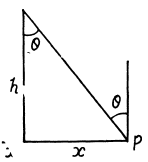
The luminous flux reaching the table is

Q.8. A vertical shaft of light from a projector forms a light spot S = 100 cm2 in area on the ceiling of a round room of radius R = = 2.0 m. The illuminance of the spot is equal to E = 1000 lx. The reflection coefficient of the ceiling is equal to p = 0.80. Find the maximum illuminance of the wall produced by the light reflected from the ceiling. The reflection is assumed to obey Lambert's law.
Ans. The illuminated area acts as a Lambert source of luminosity M = πL where

The equivalent luminous intensity in the direction making an angle θ from the vertical is

and the illuminance at the point P is

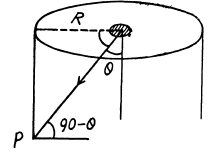
This is maximum when

or
Then the maximum illuminance is

This illuminance is obtained at a distance  from the ceiling. Substitution gives the value
from the ceiling. Substitution gives the value
0.21 lux
Q.9. A luminous dome shaped as a hemisphere rests on a horizontal plane. Its luminosity is uniform. Determine the illuminance at the centre of that plane if its luminance equals L and is independent of direction.
Ans. From the definition of luminance, the energy emitted in the radial direction by an element dS of the surface of the dome is


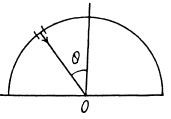
where dA is the area of an element on the plane illuminated by the radial light. Then

The illuminance at 0 is then

Q.10. A Lambert source has the form of an infinite plane. Its luminance is equal to L. Find the illuminance of an area element oriented parallel to the given source.
Ans. Consider an element of area dS at point P.
It emits light of flux

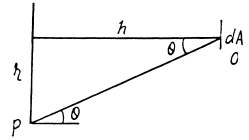
in the direction of the surface element dA at O.
The total illuminance at O is then

But

Substitution gives 
Q.11. An illuminant shaped as a plane horizontal disc of radius R = 25 cm is suspended over a table at a height h = 75 cm. The illuminance of the table below the centre of the illuminant is equal to E0 = 70 lx. Assuming the source to obey Lambert's law, find its luminosity.
Ans. Consider an angular element of area

Light emitted from this ring is

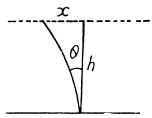
Now 
where dA = an element of area of the table just below the untre of the illuminant Then the illuminance at the element dA will be

where Finally using luminosity M = πL
Finally using luminosity M = πL

or 
Q.12. A small lamp having the form of a uniformly luminous sphere of radius R = 6.0 cm is suspended at a height h = 3.0 m above the floor. The luminance of the lamp is equal to L = 2.0.104 cd/m2 and is independent of direction. Find the illuminance of the floor directly below the lamp.
Ans. See the figure below. The light emitted by an element of the illuminant towards the point 0 under consideration is

The distance
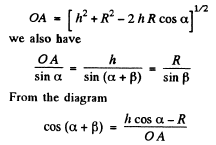


Hence, the illuminance at O is





Substitution gives : 
Q.13. Write the law of reflection of a light beam from a mirror in vector form, using the directing unit vectors e and e' of the inci- dent and reflected beams and the unit vector n of the outside normal to the mirror surface.
Ans. We see from the diagram that because of the law of reflection, the component of the incident unit

Q.14. Demonstrate that a light beam reflected from three mutually perpendicular plane mirrors in succession reverses its direction.
Ans. We choose the unit vectors perpendicular to the mirror as the x, y,-z axes in space. Then after reflection from the mirror with normal along x axis

where  are the basic unit vectors. A fter a second reflection from the 2nd mirror say along y axis.
are the basic unit vectors. A fter a second reflection from the 2nd mirror say along y axis.

Finally after the third reflection

Q.15. At what value of the angle of incident θ1 is a shaft of light reflected from the surface of water perpendicular to the refracted shaft?
Ans. Let PQ be the surface of water and n be the R.I. of water. Let AO is the shaft of light with incident angle θ1 and OBand OC are the reflected and refracted light rays at angles
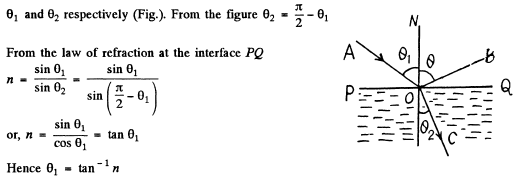
Q.16. Two optical media have a plane boundary between them. Supposeθicr is the critical angle of incidence of a beam and θ1 is the angle of incidence at which the refracted beam is perpendicular to the reflected one (the beam is assumed to come from an optically denser medium). Find the relative refractive index of these media if 
Ans. Let two optical mediums of R.I.n1 and n2 respectively be such that n1 >n2 . In the case when angle of incidence is  (Fig.), from the law of refraction
(Fig.), from the law of refraction
 (1)
(1)

In the case , when the angle of incidence is θ1, from the
law of refraction at the interface of mediums 1 and 2 .

But in accordance with the problem 
so,  (2)
(2)
Dividing Eqn (1) by (2)

or,  (3)
(3)
But 
So,  (Using 3)
(Using 3)
Thus 
Q.17. A light beam falls upon a plane-parallel glass plate d=6.0 cm in thickness. The angle of incidence is θ = 60°. Find the value of deflection of the beam which passed through that plate.
Ans. From the Fig. the sought lateral shift

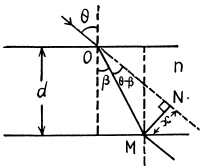
But from the law of refraction


Thus

Q.18. A man standing on the edge of a swimming pool looks at a stone lying on the bottom. The depth of the swimming pool is equal to h. At what distance from the surface of water is the image of the stone formed if the line of vision makes an angle θ with the normal to the surface?
Ans. From the Fig.

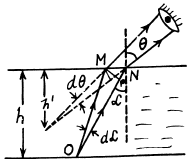
Similarly

From Eqns (1) and (2)
 (3)
(3)
From the law of refraction
 (A)
(A)
 (B)
(B)
Differentiating Eqn.(A)
 (4)
(4)
Using (4) in (3), we get
 (5)
(5)
Q.19. Demonstrate that in a prism with small refracting angle θ the shaft of light deviates through the angle  regardless of the angle of incidence, provided that the latter is also small.
regardless of the angle of incidence, provided that the latter is also small.
Ans. The figure shows the passage of a monochromatic ray through the given prism, placed in air medium.
From the figure, we have
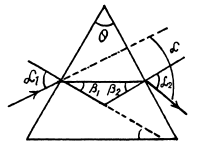
From the Snell’s law


From Eqns (1), (2) and (3), we get

So,
Q.20. A shaft of light passes through a prism with refracting angle θ and refractive index n. Let a be the diffraction angle of the shaft. Demonstrate that if the shaft of light passes through the prism symmetrically,
(a) the angle a is the least;
(b) the relationship between the angles α and θ is defined by Eq. (5.1e).
Ans. (a) In the general case, for the passage of a monochromatic ray through a prism as shown in the figure of the soln. of 5.19,
 (1)
(1)
And from the Snell’s law,




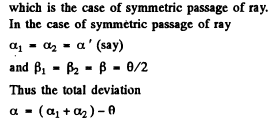
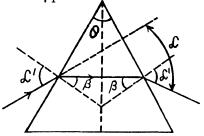
 (1)
(1)
But from the Snell’s law 
So, 
Q.21. The least deflection angle of a certain glass prism is equal to its refracting angle. Find the latter.
Ans. In this case we have


Q.22. Find the minimum and maximum deflection angles for a light ray passing through a glass prism with refracting angle θ = 60°.
Ans. In the case of minimum deviation

Passage of ray for grazing incidence and grazing imergence is the condition for maximum deviation (Fig.). From Fig.
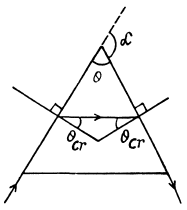

Q.23. A trihedral prism with refracting angle 60° provides the least deflection angle 37° in air. Find the least deflection angle of that prism in water.
Ans. The least deflection angle is given by the formula,
 is the angle of incidence at first surface and θ is the prism angle.
is the angle of incidence at first surface and θ is the prism angle.
Alsofrom Snell’s law, as the a ngle of refraction at first surface is equal to half the angle of prism for least deflection
as the a ngle of refraction at first surface is equal to half the angle of prism for least deflection

Q.24. A light ray composed of two monochromatic components passes through a trihedral prism with refracting angle θ = 60°. Find the angle Δα between the components of the ray after its passage through the prism if their respective indices of refraction are equal to 1.515 and 1.520. The prism is oriented to provide the least deflection angle.
Ans. From the Cauchy’s formula, and also experimentally the R.I. of a medium depends upon the w avelength of the mochromatic ray i.e. In the case of least deviation of a monochromatic ray the passage a prism, we have:
In the case of least deviation of a monochromatic ray the passage a prism, we have:
 (1)
(1)
The above equation tales us that we have n = n (α) , so we may write
 (2)
(2)
From Eqn. (1)

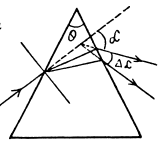
or
 (3)
(3)
From Eqn. (2) and (3)


Thus 
Q.25. Using Fermat's principle derive the laws of deflection and refraction of light on the plane interface between two media.
Ans. Fermat’s principle : “ The actual path of propagation of light (trajectory of a light ray ) is the path which can be followed by light with in the lest time, in comparison with all other hypothetical paths between the same two points. ” “Above statement is the original wordings of Fermat ( A famous French scientist of 17th century)”
Deduction of the law of refraction from Fermat’s principle : Let the plane S be the interface between medium 1 and medium 2 with the refractive indices  Fig.(a). Assume, as usual, that n1<n2 . Two points are g iv en - one above the plane S (point A ), the other under plane S (point B ). The various distances are :
Fig.(a). Assume, as usual, that n1<n2 . Two points are g iv en - one above the plane S (point A ), the other under plane S (point B ). The various distances are :
 We must find the path from A to B which can be covered by light faster than it can cover any other hypothetical path. Clearly, this path must consist of two straight lines, viz, AO in medium 1 and OB in medium 2; the point O in the plane S has to be found.
We must find the path from A to B which can be covered by light faster than it can cover any other hypothetical path. Clearly, this path must consist of two straight lines, viz, AO in medium 1 and OB in medium 2; the point O in the plane S has to be found.
First of all, it follows from Fermat’s priniciple that the point O must lie on the intersection of S and a plane P, which is perpendicular to S and passes through A and B.
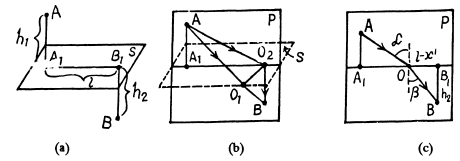
Indeed, let us assume that this point does not lie in the plane P; let this be point 0 1 in Fig. (b). Drop the perpendicular O2 from O1 onto P . Since AO2 < AO1 and BO2< BO1 it is clear that the time required to traverse AO2B is less than that needed to cover the path AO1B.
Thus, using Fermat’s principle, we see that the first law of refraction is observed : the incident and the refracted rays lie in the same plane as the perpendicular to the interface at the point
where the ray is refracted. This plane is the plane P in Fig. (b); it is called the plane of incidence.
Now let us consider light rays in the plane of incidence Fig. (c). Designate
 The time it takes a ray to travel from A to O and then from O to B is
The time it takes a ray to travel from A to O and then from O to B is
 (1)
(1)
The time depends on the value of x. According tofermat's principle, the value of x must m inim ize the time T. A t this value of x the derivative dT/dx equals zero :
 (2)
(2)
Now,

Consequently,

So,

Note : Fermat himself could not use Eqn. 2. as mathematical analysis was developed later by Newton and Leibniz. To deduce the law of the refraction of light, Fermat used his own maximum and minimum method of calculus, which, in fact, corresponded to the subsequently developed method of finding the minimum (maximum) of a function by differentiating it and equating the derivative to zero.
Q.26. By means of plotting find: (a) the path of a light ray after reflection from a concave and convex spherical mirrors (see Fig. 5.4, where F is the focal point, 00' is the optical axis);
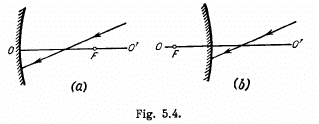
(b) the positions of the mirror and its focal point in the cases illustrated in Fig. 5.5, where P and P' are the conjugate points.

Ans. (a) Look for a point O' on the axis such that O' F and O' P make equal angles with O' O.
This determines the position of the mirror. Draw a ray from P parallel to the axis. This must on reflection pass through F. The intersection of the reflected ray with principal axis determines the focus.
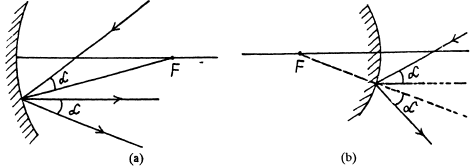
(b) Suppose P is the object and F is the image. Then the mirror is convex because the image is virtual, erect & dim inished. Look for a point X (between P & F ) on the axis such that PX and F'X make equal angle with the axis.

Q.27. Determine the focal length of a concave mirror if:
(a) with the distance between an object and its image being equal to l = 15 cm, the transverse magnification β = —2.0;
(b) in a certain position of the object the transverse magnification is β1 = —0.50 and in another position displaced with respect to the former by a distance l = 5.0 cm the transverse magnification β2 = = —0.25.
Ans. (a) From the mirror formula,
 (1)
(1)
In accordance with the problem 
From these two relations, we get : 
Substituting it in the Eqn. (1),

 (2)
(2)
Now , it is clear from the above equation, that for smaller p , s must be large, so the object is displaced away from the mirror in second position.
i.e. (3)
(3)
Eliminating 5 from the Eqn. (2) and (3), we get,

Q.28. A point source with luminous intensity I0 = 100 cd is positioned at a distance s = 20.0 cm from the crest of a concave mirror with focal length f = 25.0 cm. Find the luminous intensity of the reflected ray if the reflection coefficient of the mirror is p = 0.80.
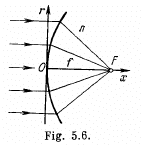
Ans. For a concave mirror as usual

(In coordinate convention s = - s is negative  is also negative.)
is also negative.)
If A is the area of the mirror (assumed sm all) and the object is on the principal axis, then the light incident on the mirror per second is
This follows from the definition of luminous intensity as light emitted per second per unit solid angle in a given direction and the fact that is the solid angle subtended by the mirror at the source. of this a fraction p is reflected so if I is the luminous intensity of the image,
is the solid angle subtended by the mirror at the source. of this a fraction p is reflected so if I is the luminous intensity of the image,
then
Hence

(Because our convention makes f - ve for a concave mirror, we have to write  )
)
Substitution gives
Q.29. Proceeding from Fermat's principle derive the refraction formula for paraxial rays on a spherical boundary surface of radius R between media with refractive indices n and n'.
Ans. For O1 to be the image, the optical paths of all rays OAO1 must be equal upto terms o f leading order in h Thus



Since this must hold for all h, we have

From our sign convention,
Q.30. A parallel beam of light falls from vacuum on a surface enclosing a medium with refractive index n (Fig. 5.6). Find the shape of that surface, x (r), if the beam is brought intofocus at the point F at a distance f from the crest O. What is the maximum radius of a beam that can still be focussed?
Ans. All rays focusing at a point must have traversed the same optical path. Thus
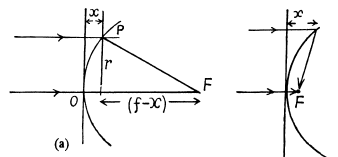


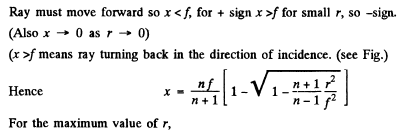
 (A)
(A)
because the expression under the radical sign must be non-negative, which gives the maximum value of r.
Hence from Eqn.
Q.31. A point source is located at a distance of 20 cm from the front surface of a symmetrical glass biconvex lens. The lens is 5.0 cm thick and the curvature radius of its surfaces is 5.0 cm. How far beyond the rear surface of this lens is the image of the source formed?
Ans. As the given lense has significant thickness, the thin lense, formula cannote be used.
For refraction at the front surface from the formula

On simplifying we get , s' = 30 cm.
Thus the image l' produced by the front surface behaves as a virtual source for the rear surface at distance 25 cm from it, because the thickness of the lense is 5 cm. Again from the refraction formula at cerve surface


Thus we get a real image l at a distance 6- 25 cm beyond the rear surface (Fig.).
Q.32. An object is placed in front of convex surface of a glass piano-convex lens of thickness d = 9.0 cm. The image of that object is formed on the plane surface of the lens serving as'a screen. Find:
(a) the transverse magnification if the curvature radius of the lens's convex surface is R = 2.5 cm;
(b) the image illuminance if the luminance of the object is L = 7700cd/m2 and the entrance aperture diameter of the lens is D = 5.0 mm; losses of light are negligible.
Ans. (a) The formation of the image of a source 5, placed at a distance u from the pole of the convex surface of plano-convex lens of thickness d is shown in the figure.

But in this case optical path of the light, corresponding to the distance v in the medium is v/n, so the magnification produced will be,

Substituting the values, we get magnification β = - 0-20.
(b) If the transverse area of the object is A (assumed small), the area of the image is β2A.
We shall assume that  Then light falling on the Jens is
Then light falling on the Jens is from the definition of luminance (See Eqn. (5.1c) of the book; here
from the definition of luminance (See Eqn. (5.1c) of the book; here
 Then the illum inance of the image is
Then the illum inance of the image is

Substitution gives 42 lx.
Q.33. Find the optical power and the focal lengths
(a) of a thin glass lens in liquid with refractive index no = 1.7 if its optical power in air is 
(b) of a thin symmetrical biconvex glass lens, with air on one side and water on the other side, if the optical power of that lens in air is 
Ans. (a) Optical power of a thin lens o f R.I. n in a m edium w ith R I . n0 is given by :
 (A)
(A)
From Eqn.(A), when the lens is placed in air :
 (1)
(1)
Similarly from Eqn.(A), when the lens is placed in liquid :
 (2)
(2)
Thus from Eqns (1) and (2)

The second focal length, is given by
 where n is the R.I. of the medium in which it is placed.
where n is the R.I. of the medium in which it is placed.

(b) Optical power of a thin lens of RI. n placed in a medium of RI. no is given by :
 (A)
(A)
For a biconvex lens placed in airmedium from Eqn. (A)
 (1)
(1)
where R is the radius of each curve surface of the lens
Optical power of a spherical refractive surface is given by :
 (B)
(B)
For the rear surface of the lens which divides air and glass medium

Similarly for the front surface which divides wati nd glass medium
 (3)
(3)
Hence the optical power of the given optical system
 (4)
(4)
From Eqns (1) and (4)

Q.34. By means of plotting find: (a) the path of a ray of light beyond thin converging and diverging lenses (Fig. 5.7, where 00' is the optical axis, F and F' are the front and rear focal points);
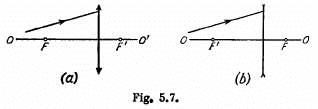
(b) the position of a thin lens and its focal points if the position of the optical axis 00' and the positions of the cojugate points P, P' (see Fig. 5.5) are known; the media on both sides of the lenses are identical; (c) the path of ray 2 beyond the converging and diverging lenses (Fig. 5.8) if the path of ray I and the positions of the lens and of its
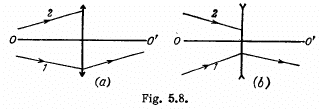
optical axis 00' are all known; the media on both sides of the lenses are identical.
Ans. (a) Clearly the media on the sides are different. The front focus F is the position of the object (virtual or real) for which the image is formated at infinity. The rear focus F' is the position of the image (virtual or real) of the object at infinity, (a) Figures 5.7 (a) & (b). This geometrical construction ensines that the second of the equations (5.1g) is obeyed
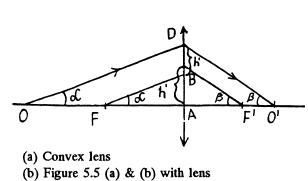
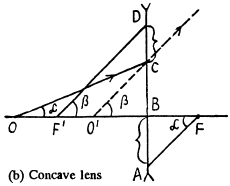
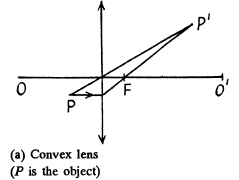
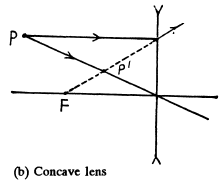
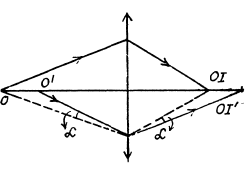
(c) Figure (5.8) (a) & (b).
Clearly, the important case is that when the rays (1) & (2) are not symmetric about the principal axis, otherwise the figure can be completed by reflection in the principal axis. Knowing one path we know the path of all rays connecting the two points. For a different object. We proceed as shown below, we use the fact that a ray incident at a given height above the optic centre suffers a definite deviation.
The concave lens can be discussed similarly.
Q.35. A thin converging lens with focal length f = 25 cm projects the image of an object on a screen removed from the lens by a distance 1=5.0 m. Then the screen was drawn closer to the lens by a distance Δl = 18 cm. By what distance should the object be shifted for its image to become sharp again?
Ans. Since the image is formed on the screen, it is real, so for a conversing lens object is in the incident side.
Let S1 and S2 be the magnitudes of the object distance in the first and second case respectively. We have the lens formula
 (1
(1
In the first case from Eqn. (1))

Similarly from Eqn.(l) in the second case

Thus the sought distance 
Q.36. A source of light is located at a distance l = 90 cm from a screen. A thin converging lens provides the sharp image of the source when placed between the source of light and the screen at two positions. Determine the focal length of the lens if (a) the distance between the two positions of the lens is Δl = = 30 cm; (b) the transverse dimensions of the image at one position of the lens are η = 4.0 greater than those at the other position.
Ans. The distance between the object and the image is l. Let x = distance between the object and the lens. Then, since the image is real, we have in our convention, 

(We must have / > 4f for real roots.)
(a) If the distance between the two positions of the lens is Δl, then clearly

(b) The two roots are conjugate in the sense that if one gives the object distance the other gives the corresponding image distance (in both cases). Thus the magnifications are

The ratio of these magnification being η we have
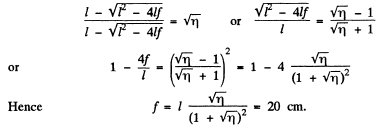
Q.37. A thin converging lens is placed between an object and a screen whose positions are fixed. There are two positions of the lens at which the sharp image of the object is formed on the screen. Find the transverse dimension of the object if at one position of the lens the image dimension equals h' = 2.0 mm and at the other, h" = 4.5 mm.
Ans. We know from the previous problem that the two magnifications are reciprocals of each other (B' β" = 1). If h is the size of the object then h' = β' h and

H ence
Q.38. A thin converging lens with aperture ratio D : f = 1: 3.5 (D is the lens diameter, f is its focal length) provides the image of a sufficiently distant object on a photographic plate. The object luminance is L = 260 cd/m2. The losses of light in the lens amount to α = 0.10. Find the illuminance of the image.
Ans. Refer to problem 5.32 (b). If A is the area of the object, then provided the angular diameter of the object at the lens is much smaller than other relevant angles like  we calculate the light falling on the lens as
we calculate the light falling on the lens as
where u2 is the object distance squared. If β is the transverse magnification then the area of the image is β2A. Hence the illuminance of the image (also taking account of the light lost in the lens)
then the area of the image is β2A. Hence the illuminance of the image (also taking account of the light lost in the lens)

since s' = f for a distant object Substitution gives E = 15 lx.
Q.39. How does the luminance of a real image depend on diameter D of a thin converging lens if that image is observed (a) directly; (b) on a white screen backscattering according to Lambert's law?
Ans. (a) If s = object distance, s' = average distance, L = luminance of the sounce, ΔS = area of the source as sumed to be a plane surface held normal to the principal axis, then we find for the flux  incident on the lens
incident on the lens

Here we are assuming D « s, and ignoring the variation of L since a is small
Then if L' is the luminance of the image, and  is the area of the image then similarly
is the area of the image then similarly

(b) In this case the image on the white screen from a Lambert source. Then if its luminance is L0 its luminosity will be the πL0 and
or 
since s' depends on f, s but not on D.
Q.40. There are two thin symmetrical lenses: one is converging, with refractive index n1 = 1.70, and the other is diverging with refractive index n2 = 1.51. Both lenses have the same curvature radius of their surfaces equal to R = 10 cm. The lenses were put close together and submerged into water. What is the focal length of this system in water?
Ans. Focal length of the converging lens, when it is submerged in water of R.I. n0 (say) :
 (1)
(1)
Similarly, the focal length of diverging lens in water.
 (2)
(2)
Now, when they are put together in the water, the focal length of the system,

or,
Q.41. Determine the focal length of a concave spherical mirror which is manufactured in the form of a thin symmetric biconvex glass lens one of whose surfaces is silvered. The curvature radius of the lens surface is R = 40 cm.
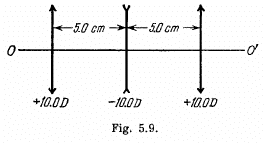
Ans.

Q.42. Figure 5.9 illustrates an aligned system consisting of three thin lenses. The system is located in air. Determine:
(a) the position of the pointof convergence of a parallel ray incoming from the left after passing through the system;
(b) the distance between the first lens and a point lying on the axis to the leftof the system, at which that point and its image are located symmetrically with respect to the lens system.
Ans. ( a ) Path of a ray, as it passes th rough the lens system is as shown below.
F o c a l le n g th of all the three lenses,
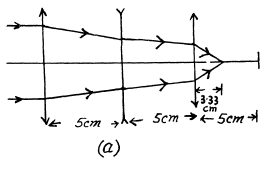
 , n e g le c t in g their signs.
, n e g le c t in g their signs.
Applying lens formula for the first lens, considering a ray coming from infinity,

and so the position of the image is 5 cm to the right of the second lens, when only the firstone is present, but the ray again gets refracted while passing through the second, so

or, s' = 10 cm, which is now 5 cm left to the third lens sofor this lens,

or,
(b) This means that if the object is x cm to be left of the first lens on the axis OO' then the image is x on to the right of the 3rd (la s t ) lens. Call the lenses 1,2,3 from the left and leto be the object, O1 its image by the first lens, O2 the image of O1 by the 2nd lens and O3, the image of O2 by the third lens.
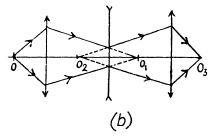
O1 and O2 must be symmetrically located with respect to the lens L2 and since this lens is concave, O1 must be at a distance  to be the right of L2 and O2 must be
to be the right of L2 and O2 must be  to be the left of L2, One can check that this satisfies lens equation for the third lens Ls
to be the left of L2, One can check that this satisfies lens equation for the third lens Ls

Hence
Q.43. A Galilean telescope of 10-fold magnification has the length of 45 cm when adjusted to infinity. Determine:
(a) the focal lengths of the telescope's objective and ocular;
(b) by what distance the ocular should be displaced to adjust the telescope to the distance of 50 m.
Ans. (a) Angular magnification for Galilean telescope in normal adjustment is given as.

or,  (1)
(1)
The length of the telescope in this case.

So, using (1), we get,


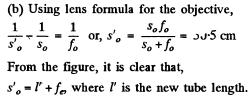

Q.44. Find the magnification of a Keplerian telescope adjusted to infinity if the mounting of the objective has a diameter D and the image of that mounting formed by the telescope's ocular has a diameter d.
Ans. In the Keplerian telescope, in normal adjustment, the distance between the objective and eyepiece is f0 + fe . The image of the mounting produced by the eyepiece is formed at a distance v to the right where

But 
so
The linear magnification produced by the eyepiece of the mounting is, in magnitude,

This equals  according to the problem so
according to the problem so

Q.45. On passing through a telescope a flux of light increases its intensity η = 4.0.104 times. Find the angular dimension of a distantobject if its image formed by that telescope has an angular dimension ψ' = 2.0°.
Ans. It is clear from the figure that a parallel beam of light, originally of intensity l0 has, on emerging from the telescope, an intensity.
because it is concentrated over a section whose diameter is fe/fo of the diameter of the cross section of the incident beam.

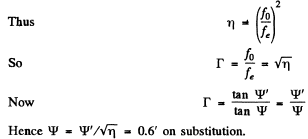
Q.46. A Keplerian telescope with magnification  = 15 was submerged into water which filled up the inside of the telescope. To make the system work as a telescope again within the former dimensions, the objective was replaced.What has the magnification of the telescope become equal to? The refractive index of the glass of which the ocular is made is equal to n == 1.50.
= 15 was submerged into water which filled up the inside of the telescope. To make the system work as a telescope again within the former dimensions, the objective was replaced.What has the magnification of the telescope become equal to? The refractive index of the glass of which the ocular is made is equal to n == 1.50.
Ans. W hen a glass lens is immersed in w ater its focal length increases approximately four times. We check this as follows as :


Now back to the problem. Originally in air

In water, 
and the focal length of the replaced objective is given by the condition

Q.47. At what magnification  of a telescope with a diameter of the objective D = 6.0 cm is the illuminance of the image of an objecton the retina not less than without the telescope? The pupil diameter is assumed to be equal to d0 = 3.0 mm. The losses of light in the telescope are negligible.
of a telescope with a diameter of the objective D = 6.0 cm is the illuminance of the image of an objecton the retina not less than without the telescope? The pupil diameter is assumed to be equal to d0 = 3.0 mm. The losses of light in the telescope are negligible.
Ans. If L is the luminance of the object, A is its area, s = distance of the object then light falling on the objective is

The area of the image formed by the telescope (assuming that the image coincides with the object) is  A and the area of the final image on the retina is
A and the area of the final image on the retina is

Where f = focal length of the eye lens. Thus the illuminance of the image on the retin (when the object is observed through the telescope) is

When the object is viewed directly, the illuminance is, similarly, 
We want 
So, on substitution of the values.
on substitution of the values.
Q.48. The optical powers of the objective and the ocular of a microscope are equal to 100 and 20 D respectively. The microscope magnification is equal to 50. What will the magnification of the microscope be when the distance between the objective and the ocular is increased by 2.0 cm?
Ans. Obviously, 
Now, we know that, magnification of a microscope,
 for distinct vision
for distinct vision
or, 
Since distance between objective and ocular has increased by 2 cm, hence it will cause the increase of tube length by 2cm.
so, 
and hence, :
Q.49. A microscope has a numerical aperture sin α = 0.12, where a is the aperture angle subtended by the entrance pupil of the microscope. Assuming the diameter of an eye's pupil to be equal to do = = 4.0 mm, determine the microscope magnification at which
(a) the diameter of the beam of light coming from the microscope is equal to the diameter of the eye's pupil;
(b) the illuminance of the image on the retina is independentof magnification (consider the case when the beam of light passing through the system "microscope-eye" is bounded by the mounting of the objective).
Ans. It is implied in the problem that final image of the object is at infinity (otherwise light coming outof the eyepiece will not have a definite diameter).


But when the final image is at infinity, the magnification  in a microscope is given by
in a microscope is given by

(b) If  is the magnification produced by the microscope, then the area of the image produced on the retina (when we observe an object through a microscope) is:
is the magnification produced by the microscope, then the area of the image produced on the retina (when we observe an object through a microscope) is:

Where u = distance of the image produced by the microscope from the eye lens, f = focal length of the eye lens and A = area of the object If φ = luminous flux reaching the objective from the object and d = d0 so that the entire flux is admitted into the eye), then the illuminance of the final image on the retina
But if  then only a fraction (d0 | d)2 of light is admitted into the eye and the illuminance becomes
then only a fraction (d0 | d)2 of light is admitted into the eye and the illuminance becomes

independentof  The condition for this is then
The condition for this is then

Q.50. Find the positions of the principal planes, the focal and nodal points of a thin biconvex symmetric glass lens with curvature radius of its surfaces equal to R = 7.50 cm. There is air on one side of the lens and water on the other.
Ans. The primary and secondary focal length of a thick lens are given as,

and 
where φ is the lens power n , n' and n" are the refractive indices of first medium, lens material and the second medium beyond the lens. are the powers of first and second spherical surface of the lens.
are the powers of first and second spherical surface of the lens.
 (1)
(1)
Now, power of a thin lens,
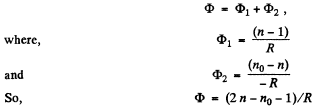 (2)
(2)
From equations (1) and (2), we get

and 
Since the distance between the primary principal point and primary nodal point is given as,
So, in this case, 
Q.51. By means of plotting find the positions of focal points and principal planes of aligned optical systems illustrated in Fig. 5.10:
(a) a telephoto lens, that is a combination of a converging and a diverging thin lenses (f1 = 1.5 a, f2 = —1.5 a);

(b) a system of two thin converging lenses 
(c) a thick convex-concave lens 

Ans.
Q.52. An optical system is located in air. Let 00' be its optical axis, F and F' are the front and rear focal points, H and H' are the front and rear principal planes, P and P' are the conjugate points. By means of plotting find:
(a) the positions F' and H' (Fig. 5.11a);
(b) the position of the point S' conjugate to the point S (Fig. 5.11b);

(c) the positions F, F', and H' (Fig. 5.11c, where the path of the ray of light is shown before and after passing through the system).
Ans. (a) Draw P' X parallel to the axis OO' and let PF interest it at X. That determines the principal point H. As the' medium on both sides of the system is the same, the principal point coincides with the nodal point Draw a ray parallel to PH through P' . That determines H' Draw a ray P X' parallel to the axis and join P'X".
That gives F' .
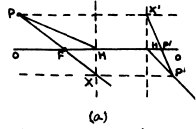
(b) We let H stand for the principal point (on the axis). Determ ine H" by drawing a ray P'H" passing through P' and parallel to PH. One ray (conjugate to SH) can be obtained from this. To get the other ray one needs to know F or F" . This is easy because P and F are known. Finally we get S'.
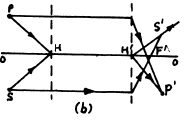
(c) From the incident ray we determine Q. A line parallel to OO' through Q determines Q and hence H'.
H and H ' are then also the nodal points. A ray p arallel to the incident ray through H will emeige parallel to itse lf through H '. That determines F . Sim ilatiy a ray parallel to the emergent ray through H determines F.
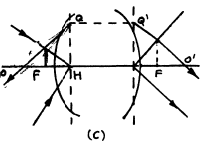
Q.53. Suppose F and F' are the front and rear focal points of an optical system, and H and H' are its front and rear principal points. By means of plotting find the position of the image S' of the point S for the following relative positions of the points S, F, F', H, and H':
(a) FSHH'F'; (b) HSF'FH'; (c) H'SF'FH; (d) F'H'SHF.
Ans. Here we do not assume that the media on the two sides of the system are the same.


Q.54. A telephoto lens consists of two thin lenses, the front converging lens and the rear diverging lens with optical powers 
 Find:
Find:
(a) the focal length and the positions of principal axes of that system if the lenses are separated by a distance d = 4.0 cm;
(b) the distance d between the lenses at which the ratio of a focal length f of the system to a distance l between the converging lens and the rear principal focal point is the highest. What is this ratio equal to?
Ans. (a) Optical power of the system of combination of two lenses,

on putting the values,

or, 
Now, the position of primary principal plane with respect to the vertex of conveiging lens,

Similarly, the distance of secondary principal plane with respect to the vertex of diverging lens.

(b) The distance between the rear principal focal point F' and the vertex of conveiging lens,

Now , if f/l is maximum for certain value of d then f/l will be minimum for the same value of d. And for minimum f/l,

Q.55. Calculate the positions of the principal planes and focal points of a thick convex-concave glass lens if the curvature radius of the convex surface is equal to R1 = 10.0 cm and of the concave surface to R2 = 5.0 cm and the lens thickness is d = 3.0 cm.
Ans. The optical power of first convex surface is,

and the optical power of second concave surface is,

So, the optical power of the system,

Now , the distance of the primary principal plane from the vertex of convex surface is given as,

and the distance of secondary principal plane from the vertex of second concave surface,

Q.56. An aligned optical system consists of two thin lenses with focal lengths f1 and f2 the distance between the lenses being equal to d. The given system has to be replaced by one thin lens which, at any position of an object, would provide the same transverse magnification as the system. What must the focal length of this lens be equal to and in what position must it be placed with respect to the two-lens system?
Ans. The optical power of the system of two thin lenses placed in air is given as,
 (1)
(1)
This equivalent fo cal length of the'system of two lenses is measured from the primary principal plane.
A s clear from the figure, the distance of the primary principal plane from the optical centre of the first is
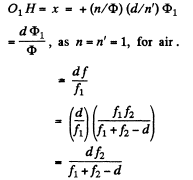
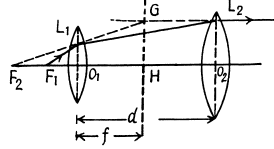
Now, if we place the equivalent lens at the primary principal plane of the lens system, it will provid e the same transverse magnification as the system. So, the distance of equivalent lens from the Vertex of the first lens is,

Q.57. A system consists of a thin symmetrical converging glass lens with the curvature radius of its surfaces R = 38 cm and a plane mirror oriented at right angles to the optical axis of the lens. The distance between the lens and the mirror is l = 12 cm. What is the optical power of this system when the space between the lens and the mirror is filled up with water?
Ans. The plane mirror forms the image of the lens, and water, filled in the space between the two, behind the mirror, as shown in the figure.

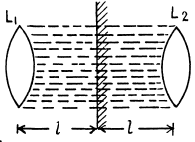
= optical power of individual lens and n0 = R.I. of water.
Now,  optical power of first convex surface + optical power of second concave surface.
optical power of first convex surface + optical power of second concave surface.
 n is the refractive index of glass.
n is the refractive index of glass.
 (1)
(1)
and so, the optical power of whole system,
 substituting the values.
substituting the values.
Q.58. At what thickness will a thick convex-concave glass lens in air
(a) serve as a telescope provided the curvature radius of its convex surface is ΔR = 1.5 cm greater than thatof its concave surface?
(b) have the optical power equal to —1.0 D if the curvature radii of its convex and concave surfaces are equal to 10.0 and 7.5 cm respectively?
Ans. (a) A telescope in normal adjustment is a zero power conbination of lenses. Thus we require



Q.59. Find the positions of the principal planes, the focal length and the sign of the optical power of a thick convex-concave glass lens
(a) whose thickness is equal to d and curvature radii of the surfaces are the same and equal to R;
(b) whose refractive surfaces are concentric and have the curvature radii R1 and R2 (R2> R1).
Ans. (a) The power of the lens is (as in the previous problem)

The principal planes are located on the side of the convex surface at a distance d from each other, with the front principal plane being removed from the con vex surface of the lens by a distance R /(n - 1) .
(b)

Q.60. A telescope system consists of two glass balls with radii R1 = 5.0 cm and R2 = 1.0 cm. What are the distance between the centres of the balls and the magnification of the system if the bigger ball serves as an objective?
Ans. Let the optical powers of the first and second surfaces of the ball of radius R1 be then
then

This ball may be treated as a thick spherical lens of thickness 2R1. So the optical power of this sphere is,
 (1)
(1)
Similarly, the optical power of second ball,

If the distance between the centres of these balls bed. Then the optical power of whole system,
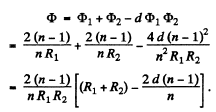
Now, since this system serves as telescope, the optical power of the system must be equal to zero.


Since the diam eter D of the ob jective is 2R1 and thatof the eye-piece is d = 2R2 So, the magnification,
Q.61. Two identical thick symmetrical biconvex lenses are put close together. The thickness of each lens equals the curvature radius of its surfaces, i.e. d = R = 3.0 cm. Find the optical power of this system in air.
Ans. Optical powers of the two surfaces of the lens are

and optical power of the combination of these two thick lenses,

So, power of this system in air is, 
Q.62. A ray of light propagating in an isotropic medium with refractive index n varying gradually from point to point has a curvature radius ρ determined by the formula

where the derivative is taken with respect to the principal normal to the ray. Derive this formula, assuming that in such a medium the law of refraction n sin θ = const holds. Here θ is the angle between the ray and the direction of the vector  at a given point.
at a given point.
Ans.



Q.63. Find the curvature radius of a ray of light propagating in a horizontal direction close to the Earth's surface where the gradientof the refractive index in air is equal to approximately 3.10-8 m-1. At what value of that gradient would the ray of light propagate all the way round the Earth?
Ans.



FAQs on Irodov Solutions: Photometry & Geometrical Optics - I. E. Irodov Solutions for Physics Class 11 & Class 12 - JEE
| 1. What is photometry in the context of geometric optics? |  |
| 2. How is photometry used in the field of geometrical optics? |  |
| 3. What are the key concepts to understand in photometry and geometrical optics for JEE exam preparation? |  |
| 4. How can I improve my understanding of photometry and geometrical optics for the JEE exam? |  |
| 5. Are there any common misconceptions students have about photometry and geometrical optics for the JEE exam? |  |

|
Explore Courses for JEE exam
|

|












